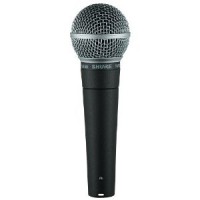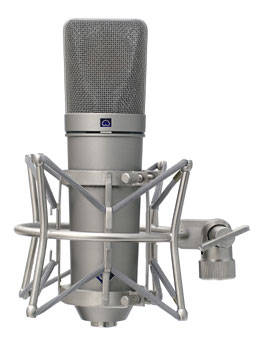VAM 011 | Microphone Basics, Part 1 – Dynamic vs. Condenser
Welcome to episode 11 of the Voice Acting Mastery podcast with yours truly, Crispin Freeman!
As always, you can listen to the podcast using the player above, or download the mp3 using the link at the bottom of this blog post. The podcast is also available via the iTunes Store online. Just follow this link to view the podcast in iTunes:
http://www.voiceactingmastery.com/podcast
In this episode, I explain the basics of how a microphone works. I also outline the differences between the two dominant types of microphones in voice acting, dynamic and condenser microphones.
Historically, microphone technology was the responsibility of the recording engineer. It used to be that you could spend your entire voice acting career not knowing how a microphone worked as long as you knew which side of it to talk into. Those days are now gone. In the age of the internet, voice actors are expected to be able to make professional quality recordings from their home studios. A solid understanding of microphones and how they function is invaluable to understanding how to use the most important tool a voice actor has.
While there are many different types of microphone technology, there are two that have become dominant in the world of voice over:
- Dynamic Microphones
- Condenser Microphones
Here are some pictures of the two microphones I mention in the podcast, the Shure SM58 Dynamic microphone and the Neumann U87 Condenser microphone:
Shure SM58 – Dynamic
Neumann U87 – Condenser
If you have any questions, please post your question as a comment to this blog post. Chances are, someone else has a similar question. By posting your question here on the blog, I get to communicate with all of you at once.
Thanks for listening!
Download Voice Acting Mastery Episode #11 Here (MP3)
24 Responses to “VAM 011 | Microphone Basics, Part 1 – Dynamic vs. Condenser”
Trackbacks/Pingbacks
- Dynamic what now? « Vox on the Rocks – VO by Eric Leach - [...] http://www.voiceactingmastery.com/vam-011-microphone-basics-part-1-dynamic-vs-condenser Spread The Fun:FacebookTwitterLinkedInEmailLike this:LikeBe the first to like this post. [...]
- Microphone Proximity Effect | Voice Acting Mastery: Become a Master Voice Actor in the World of Voice Over - [...] just put up a great video post about proximity effect. For those of you who’ve listened to episode 11…



I was JUST looking through buying a new microphone when this popped up! Such useful information!
What’s your opinion on the Samson CO1U? It’s a condenser mic that most VAAers have. Is it worth investing in?
I’m kinda outgrowing less-than-par recordings with unwanted white noise, however small. And Rockband mic is getting slightly worse and worse with recording lately.
How often should you change your mics? If at all?
Thanks in advance!
There are many USB mics that are fine for amateur projects. The Samson is one of them. However, if you want to sound competitive with the professionals, the Shure PG42USB microphone is the one to go with. I’ve heard that people have also had good experiences with the Blue Yeti, but I’m not the biggest fan of their mics. I bought the Shure 42USB myself and have done some tests against my Neumann and the Shure sounds really good. I’m going to be using the Shure to record on my iPad in the future!
Ideally, you shouldn’t have to change your mics. Microphone technology hasn’t really changed much since the 1960s. The Neumann U87 has been the industry standard for more than 50 years. If you buy a nice microphone and take care of it, you never need upgrade. My first professional microphone was an Audio-Technica 4033. It was a relatively inexpensive condenser microphone for around $300. Eventually, I grew out of that microphone and into the Neumann I use today and will probably use forever. I’m still using my Sennheiser MD421 as my travel mic and plan on using it forever. I just got the Shure PG42 to use with my iPad since I can’t use the MD421 with the iPad. If you buy an industry standard microphone, it never goes obsolete. Your interfaces and recording technology will change, but the microphone won’t.
Hope that helps.
All right! I was going to put a new mic on my Christmas list, I didn’t know which to go with. I tend to have super expensive Christmas lists. I’m so terrible! My poor parents!
Thanks for the advice!
Such big information I can’t keep up with my head but very educational and I thank you for this podcast about which microphone to use I should try this sometime but at least which microphone I can use to do voice acting Merci Mr. Freeman
Sincerely,
Angelican Marcos 🙂
Certainly very helpful information with respect to microphones and what a VA should know about them.
I do have a few questions however, particularly with respect to dynamic mics and a comment you made earlier about recording on your iPad.
When you’re on the road and you need to record something, given the choice, would you prefer to record something on your iPad or something like a laptop? And given how well a dynamic records, is this even a concern in the first place? Noticeable differences, if any?
Thanks very much, and looking forward to the next podcast as always.
I haven’t recorded on my iPad as much as I’ve recorded on my laptop. Obviously, I’m more familiar with recording on my laptop and have access to better tools on my laptop. Using my iPad to record auditions when I’m on the road is just to have the option in case I don’t want to bring my whole laptop rig.
Right now, there’s no easy way to use a dynamic microphone with an iPad unless you buy a USB dynamic mic. So I’m using the Shure PG42 condenser with my iPad. We’ll see how it goes.
Ideally when I’m on the road, a dynamic is usually more flexible in terms of dealing with room noise, but you gotta do what you gotta do. If I can only get pro-quality sound out of a USB condenser mic, then the Shure PG42 it is with my iPad.
Such a valuable episode! I’ve had some trouble doing research in comparing microphones for VO actors all over the internet, and you go sum it all up in ten minutes for me 🙂 I feel much more confident in knowing where I stand with my current mic (AT2020 USB), and now I finally know that terminology they print on the box :p
Also, it’s comforting to know that any future technology won’t make these microphones obsolete. It sure makes the idea of saving up much more appetizing! Can’t wait for the next episode!
So glad you enjoyed the episode and that it wasn’t too technical for you! I’m also glad you understand the value of your microphone now. It can give one a greater sense of mastery to understand the mechanics behind things.
I am going into animation but I had to learn about microphones in fundamentals of audio from my college. I prefer dynamic microphones, since I don’t like borrowing condensers, they are worth so much. That and the atmospheres in which I record sounds usually have a lot of unwanted background noise such as air conditioners and things. Unless I was recording Foley for an animation I would have to get a Condenser mic.
It’s true, dynamic microphones can be much better at rejecting noise in a less than ideal recording situation. They just require better amplification to sound their best. Sounds like you’ve found a system that works for you.
Do you have a preferred compressor setting for voice acting (Besides threshold of course since that varies on input source). If not what are some of the things I should listen for in using a compressor for mixing voice acting? Thanks
I do not have a “preferred” compressor setting. I use different settings depending on what I’m doing.
Everyone has their own “special sauce” settings for their compressors. In promos and trailers, they use a lot of dynamic compression, whereas in animation they try to use very little. It depends on the task at hand.
Sorry I can’t be more specific, but it really depends on what you’re trying to accomplish.
I was looking on craiglist for good and cheap mics and I found a AK A515 type V Condenser Mic. In great condition for $50. Is it a good mic. for beginners? Also is it worth the price?
Thank you Crispin
I am not familiar with that microphone so I don’t have any opinion about it. I don’t know if it’s good or not. I can’t possibly keep track of every microphone that is out there.
I can only recommend microphones that I am familiar with. There are certain microphones that get used over and over again in voice over. Those are the ones that I recommend in my Toolbox Section.
Hello,
I’ve recently purchased my first professional quality microphone. I took your advice and picked up a PG-42 … except that it isn’t the USB version. (Yay, my first mistake!) I’ve seen that there are XLR to USB cables available. Do you have any experience with those? If so, do you think I’ll be fine with one of those or if there are problems with hooking things up that way? Note that I’m still very new to this and right now, I’m just looking to get comfortable with the sound of my voice and to experiment. Thanks for all the advice you’ve given me already and keep doing what you’re doing!
Sorry you ended up getting the normal, XLR version of the PG-42 and not the USB version. I recommend the USB version just to make it simpler for people who may not be as technically inclined with audio equipment. The normal, XLR version is great too though, you’ll just need to use a USB audio interface to connect it to your computer.
As far as I’m aware, there’s no such thing as an XLR to USB cable. XLR is an analog audio cable while USB is a digital computer interface. They couldn’t be more different from each other. Usually what is required is an interface that digitizes the analog signal generated by the microphone and transmits that digital information via USB to your computer. In the toolbox section I recommend a couple of different XLR to USB interfaces including the CEntrance MicPort Pro. You will need to use some sort of USB audio interface to make your XLR PG-42 work with you computer.
Hope that helps!
Hello! I know this is an older podcast, but I’m new tuning into them. I thought I would let you know that I noticed amazon offers a package deal on the blue yeti microphone, if you’d like to update your toolbox for novice voice artists. The kit comes with the microphone, JVC headphones, pop filter, and microphone stand adapter for $139.99. It may be useful for anyone starting out!
I’ve posted a link below,
All the best!
http://amzn.to/1kN0KRD
Thanks for the link! Unfortunately, many times those packages disappear after a while so I usually don’t link to them directly. Also, I’m not familiar with those headphones so I’m not sure I can recommend them whole-heartedly.
After reading some of the reviews, people don’t seem too happy with the package. They like the mic, but not the pop filter. I’ve never seen a standard pop filter attached to a Blue Yeti that way, but maybe it works. I just don’t know.
But thank you for offering to give people another package that could work for them. I appreciate it.
Also, I shortened your URL for you. Hope you don’t mind.
Oh my goodness, my apologies for not being more thorough! I didn’t read the reviews. It popped into my recommendations while looking for studio headphones.
I’m always on the lookout for a good sale, but quality can’t be sacrificed!
No worries on the URL. It was a mouthful for sure! 🙂
Hey Crispin, Adam here from the UK. I’ll be posting a review on iTunes too, but I wanted to ask your opinion. I’m a Dad of two with a Full Time job as a customer trainer I’m on pretty good money. Now I have been on various sites for the past couple of months applying and auditioning for various voice acting work. Currently I’m looking alot of ranges to try and “find my voice”. I’ve not had much success so far, but I’m hopefull and will persevere.. Anyway, I was hoping to sometime soon sign up to some sort of course too. BUT being a Dad of two O have responsibilities and I wondered f you could help with transitions to this new line of work. As you say you need to be flexible and I want to be flexible but I feel untill I have some experience I wont be able to commit fully without having to make sacrifices.. what do you think? Great podcast!! I know I’m a little behind but I love the short bursts of info each episode provides! All the best. Adam
Hi there Adam. I’m the comments moderator for the Voice Acting Mastery website. I’m not Crispin, but I can offer some insight to your question.
I personally know some voice actors who started with full-time jobs and did voiceover whenever they had free time. Clearly they had a lot of time and dedication, as they’ve all transitioned from their day jobs to doing voiceover full time. At some point they each had to choose which they wanted to dedicate more of their time. Generally speaking, I find many of these voice actors were booking more and more VO work that they felt compelled to leave their day jobs that didn’t allow them to be flexible. There’s definitely sacrifices to be made when committing to voice acting for a living. It also doesn’t hurt to have some money saved up when you make the leap.
Hope that helps.
Hi, Crispin.
I have read over your toolbox and have been reviewing all of your professional recommendations. I would, however, like your opinion on a handful of other options, if you wouldn’t mind.
1. Rode NT1-A
2. Shure SM7B
3. Blue Yeti Pro (XLR)
4. Sennheiser MK4
I appreciate your opinion and all you do for the voice acting community.
Regards,
Matt
1. I haven’t worked with the Rode NT1 much, but in the past when I’ve worked on it, it’s always sounded thin to me in comparison to other condenser microphones.
2. The SM7B is a classic workhorse microphone and sounds great, but it requires a ton of gain to work well. If you plug it into your normal USB powered audio interface, they usually don’t have enough gain to power the SM7B without a ton of hiss. If you wanted to get a CloudLifter to help give the SM7B more gain, you totally could, but it complicates your input chain and makes you much less portable. Totally up to you.
3. I’ve not worked on the Yeti Pro, but the diaphragms on the Yeti are small diameter and don’t give the same tonal quality as a large diameter diaphragm microphone. I usually stick with the large diaphragm mics for voice over.
4. I have zero experience with the Sennheiser MK4 and I’ve never seen it used in recording studios in LA.
Hope that helps!
microphone technology was the responsibility of the recording engineer. It used to be that you could spend your entire voice acting career not knowing how a microphone worked as long as you knew which side of it to talk into. Those days are now gone. In the age of the internet, voice actors are expected to be able to make professional quality recordings from their home studios. A solid understanding of microphones and how they function is invaluable to understanding how to use the most important tool a voice actor has.